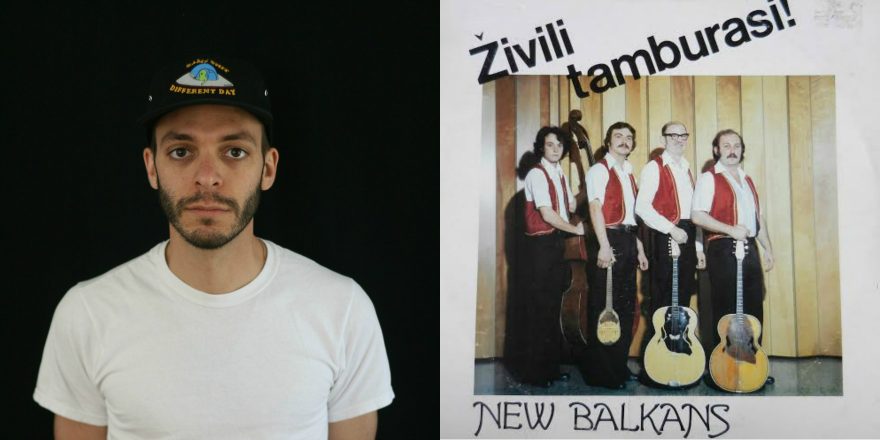Kuzman’s in Youngstown, Ohio, is the kind of place that exists outside of trends. When you walk in, it feels like it probably hasn’t changed much since the late ’70s: there’s a coat room, the walls are red, and there are these drinking scenes painted above the bar — a guy asleep next to a barrel, a couple dancing. The drinks are cheap, the hot dogs are cheaper, and at 11 p.m. they serve free coffee and donuts at the bar to sober you up and give you a little sugar rush for the drive home. (Most of the people there have been dancing for four hours!)
When he was alive, John Kuzman himself took money at the door. He seemed like a tall guy sitting behind that little table. When my friends and I visited, he always joked that we didn’t have to pay until we were better dancers. He seemed pretty excited that some young faces were there. I didn’t realize it at the time, but this was my first exposure to what I now see as a rare example of a regional music scene in a rather homogenized world — even if it wasn’t the type of music I was used to.
I first went to Kuzman’s in high school, back in 2004. It’s not a place that high school kids go to. It’s a dancehall in my hometown (where I currently live), where you can go see polka bands every Saturday night — not many folks under the age of sixty there. At the time, my brother and I were writing music — for our band the Building —which was becoming more and more influenced by Youngstown and the people there. Being of Italian heritage, we were originally interested in checking out Rocky Chirchiglia, a local Italian guitarist we knew about. When my mom heard whom we were going to see, she said we should also see Del Sinchak, who is a local legend. Del is a Grammy-nominated accordion player and bandleader, as well as one of the owners of Peppermint Productions, a studio and label. We looked in the paper and saw he was playing that Saturday at Kuzman’s.
This was the beginning of my very unlikely obsession with polka and tamburitza music.
As someone who spends most of his time playing in rock bands, this was the beginning of my very unlikely obsession with polka and tamburitza music. My interest is mostly in records and musicians that come from the Northeast Ohio/Western Pennsylvania region (they have their own organization: the Penn-Ohio Polka Pals). I’ve learned that Youngstown is a hot bed for this kind of stuff; I have a decently large collection of LPs that were either recorded in the area or released on one of the many ethnic music labels that were located here. From Cleveland to Pittsburgh — and I’m sure many other cities that saw a wave of Eastern European immigrants in the early twentieth century — there were labels and artists that served not only a huge audience of Slavic listeners, but also the general public. It was popular music, but Peppermint Records is the only remaining label in this area still putting out new recordings — which they produce in-house at their incredible studio. This music is very much a living tradition, held together by CDRs, AM radio shows, church festivals, shitty websites and Kuzman’s.
Back when we were teens, my friends and I just wanted listen to the band and see what was going on at first, but you can’t go to Kuzman’s and not dance — let alone be a younger person and not dance. Couples kept coming up to us and asking why we were there and insisting that they teach us to dance. Next thing you know, we’re circling the floor in someone’s grandma’s arms. For me, that’s when the place stopped being a novelty and became a really important experience — mostly because I was forced way outside my comfort zone, which is more than I can say for most of the shows I went to. To dance with someone you’ve never met is a very intimate thing, especially when you’re holding your partner like you do with polka dancing. Touching is something that my generation doesn’t do much of in social situations. If you’re at a bar or a show and you meet someone, you may end up talking, texting, whatever — but you’re not likely to find yourself holding that person unless you’ve both already decided that you like each other. And you are way less likely to be doing that with someone three or four times your age. And way, way less likely to do that with someone who doesn’t share the same cultural interests as you. But at Kuzman’s, that happens.
There was also an old lady at the bar having coffee who told me that when she dies, she wants to be shot by a jealous wife.
My assumptions about the older regulars were immediately confronted when I engaged in their scene. Men who I assumed were your standard, emotionless old dude were coming up to me, taking me in their arms and giving nuanced tips about how I should place my right hand on my partner’s shoulder blade, not just their back, so that they will know where I’m trying to lead them. A rather flashy guy, probably in his eighties — wearing an all-white suit with gold embroidery and a Nehru collar — asked what kind of music we played and encouraged us to keep dancing. There was also an old lady at the bar having coffee who told me that when she dies, she wants to be shot by a jealous wife (“I want to be coming and going at the same time!”).
The idea of a single senior citizen making dirty jokes to strangers at a bar — at midnight on a Saturday — seems hard to imagine, I know. But, then, we don’t tend to socialize outside of our peer group in general. Many folks my age live in neighborhoods that cater to the young — and they don’t see much crossover. That’s not all bad, but I do think this segregation can lead to living with blinders on; you tend to focus on your own group and lose sight of what else is happening around you.
At the same time, I think the older folks’ preconceived ideas about my friends and me changed, too. We come in looking like people in their twenties who play rock music: tight jeans, T-shirts, tennis shoes — total clichés. Then they’ll ask how we heard of the place, ask what we do, ask if we have anything on YouTube. One guy asked if we were students at Youngstown State University, doing an assignment for class. When I assured him that we weren’t, he responded, “There’s something wrong with you then.” But at some point they realized we were there for the same reason they were: to hear the bands, dance, drink and have a good time.
Except, for us, Kuzman’s is something that exists as a “unique experience” — something that, even though we are there without irony, is still something that isn’t a part of our experience as a whole. Even if all older people aren’t into polka specifically, they at least have some experience dancing in a social setting, whereas with my friends and me…when we tell our peers about out favorite hangout spot, there’s some eyebrow-raising. That kind of dancing is not an activity that exists in the twentysomething’s life.
Despite all the weird, out-there music I’ve been into, polka is the one that is universally met with disgust.
I’ve had the opportunity to tour with some very popular bands (The War on Drugs, Dean & Britta, St. Vincent), but most of my personal musical projects outside of that have been pretty experimental (for lack of better word) — from playing Simmons electronic drums with New Amsterdam recording artist No Lands to making sound collage work about Thomas Merton with my close friend and collaborator Angelo Spagnolo. A lot of this stuff has been documented on my label, Primary Records — including solo baritone sax records and a band in which I played percussion only using microphones (I’m sure at this point your eyes have rolled fully out of their sockets). I bring all this up only to emphasize the fact that despite all the weird, out-there music I’ve been into, polka is the one that is universally met with disgust.
If you tell someone that you like polka music, they will respond with a judgy, “Really?” You put on a Jimmy Sturr CD in the car with your friends and see how much they complain and ask you to “turn that shit off!” I think it’s safe to say that polka is taken less seriously than any kind of music in history. That being said, I don’t think anyone has ever tried to raise the art form, so to speak. I’m not sure that there’s a Sgt. Pepper’s of polka. There’s nothing really deeper to “get.” It’s just fun dance music.
The songs are mostly about polka music — or drinking or pierogies. And I only bring this up to show that I’m not trying to create a hipper-than-thou polka subculture. Polka is definitely uncool, which makes its presence and our participation in it even more important. In a social media- and image-driven society where lifestyle and fashion are amongst the most prized commodities, being into something that is this uncool doesn’t hold much appeal. I’m sure there are those that will argue that I am attracted to this world as some sort of next-level hipster who will be into anything as long as it’s not what you are into — and I’m sure that if polka were to ever gain popularity outside my own circle of friends, that might be true.
But I am coming at this very genuinely. I see it as a stronghold that flies in the face of Justin Moyer’s 2012 Washington City Paper article “Our Band Could Be Your Band,” wherein he wrote that regional music largely no longer exists. I love that article, and I work very hard to personally not write music that contributes to the sentiment he describes. I write music about Youngstown, about Italian-Americans and the shit we do — like canning peppers. When I moved back here and started working on a new album, I recorded it with Gary Rhamy at Peppermint Productions, who engineered many of these polka and tamburitza records that I love. I have even had a few friends travel here to record with him as well. Why? Because it is a regional scene, and I want to be a part of it. (Don’t get me wrong; I also want to sing into a Telefunken 251 from the ’60s that’s running through a console full of UA 1008 mic-pre’s.)
That’s where I think the heart of my obsession lies. It started as confounded curiosity when I first saw the album cover for the New Balkans’ Zivili Tamburasi, a tamburitza record from the late ’70s that I stole from my high school’s music library. (For those who aren’t familiar, tamburitza music is Balkan string music. While I’ve been talking mostly about polka, it’s mostly tamburitza records that I really like to listen to.) At first I just thought that the cover was funny, with these old guys in vests and a pimply teenager on bass. But then I put it on and realized that these dudes could play — I mean an extremely high level of musicianship. Then I realized that it was one of the best sounding records I owned and it was recorded a few blocks from where I lived.
I hope it’s not just something people put on in the background at the local single-origin espresso spot, but something that people actively participate in.
I became obsessed with all things Peppermint, and all things in the Youngstown ethnic music scene. I collect any records I can find that were recorded by Gary on Peppermint, as well as its predecessors WAM and United Audio. Marjon was another ethnic label, out of Sharon, Pennsylvania. I have a couple of compilations of 45s a friend of mine has collected of rock and soul music that was recorded by Gary at Peppermint, but released on Tammy Records. I try to catch Dennis Spisak’s show on WKTL every Saturday, where he updates us on which bands are playing where, when the pierogi sale at St. Stan’s is, and if there are any cabins available at Slovenefest this year (there weren’t). It was on Dennis’ show where I first heard about Angela White, a musician in her early twenties who just released a tamburitza record called Devet. She played all the instruments and recorded it at home. That doesn’t sound that remarkable to most people, as that’s the way so many musicians make records these days, but for someone outside of that scene, it was cool to hear that she was doing the same thing we do — just with tamburitza music.
So that’s it. I’m not sure what I’ve achieved by writing this, but I feel compelled to tell as many people as possible that this world exists and that it is a vital and exciting part of the culture in this region. I hope more people get into it. Hell, I hope Numero Group or Light in the Attic puts out a Youngstown ethnic music compilation. But I hope it’s not just something people put on in the background at the local single-origin espresso spot, but something that people actively participate in. I hope it reminds people that having unique regional character is exciting, no matter how uncool your particular region may be.









